…where east meets west
- Home
- Brief History
- The Greenwich Meridian
- Greenwich
(1675–1958) - Herstmonceux
(1948–1990) - Cambridge
(1990–1998) - Outstations (1822–1971)…
- – Chingford (1822–1924)
- – Deal
(1864–1927) - – Abinger
(1923–1957) - – Bristol & Bradford on Avon
(1939–1948) - – Bath
(1939–1949) - – Hartland
(1955–1967) - – Cape of Good Hope
(1959–1971)
- Administration…
- – Funding
- – Governance
- – Inventories
- – Pay
- – Regulations
- – Royal Warrants
- Contemporary Accounts
- People
- Publications
- Science
- Technology
- Telescopes
- Chronometers
- Clocks & Time
- Board of Longitude
- Libraries & Archives
- Visit
- Search
Astronomical Regulators: Shortt ‘free-pendulum’ clocks Nos: 3, 11, 16, 40, 49, 61, 66 & 67
Page under construction
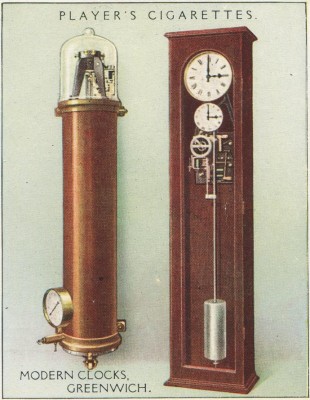
The master (left) and slave (right) of Shortt 3. In order to function, the master and slave needed to be wired together. At Greenwich, they were mounted in different buildings. Card 20 (of 20) from the John Player series Clocks – Old & New (1928)
The Observatory’s first Shortt Clock, Shortt 3, was delivered in the autumn of 1924. It took over from the Cottingham clock as the sidereal standard on 1 January 1925. The Observatory’s third clock, Shortt 16, was delivered in 1927 and became the new mean solar standard. By the start of the Second World War, the Observatory owned five Shortts, four of which had been purchased and one of which had been donated by Henry Reginald Fry.
Located close to the Thames in London, Greenwich was particularly vulnerable to bombing raids when the war began. As a result, two emergency time stations were set up and three further clocks obtained. The first time station (known for security reasons as Station A) was at the Observatory’s outstation, the Magnetic Observatory in Abinger. The second (Station B) was at the Royal Observatory Edinburgh.
By the early 1960s, the Shortt Clocks had all been retired. They were superceeded by the Observatory’s Quartz clocks, which had taken over some of their functions in the mid 1940s and most of the rest in 1949.
Principle of operation
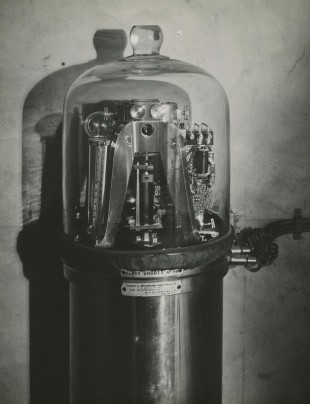
Movement and support for the master pendulum of Shortt 49. Note the serial number on the case and the air-tight wax seal immediately above it. November 1937, Humphry Smith photographic archive
Amongst the design features of the Riefler clocks were a pendulum made of a newly invented material called invar (which had a low expansivity, reducing any change in length with temperature), a new form of escapement and an electric winding system that allowed all the moving parts of the clock to be placed in a partially evacuated chamber to eliminate the effect of changes in atmospheric pressure on the pendulum which would otherwise affect the amplitude of the swings.
Shortt took these ideas a stage further. Inspired by the work of R.J. Rudd, he developed a clock system that made use of two separate units (a master and a slave) linked in a phase-locked loop. The task of unlocking an impulse to an otherwise free master pendulum was taken on by the slave clock, which did the job of counting the swings but was also corrected by a synchronising pulse derived from the master clock containing the free pendulum. As in the Rieflers, the master pendulum rod was made of invar, but with two main differences. Firstly, although changes in its length as a result of thermal expansion had been minimised by the use of invar, a compensation system was put in place for the small changes in its length that did occur, by the insertion of a piece of brass with carefully selected dimensions into the bob (which was made of type-metal), using what was essentailly a modification of the gridiron principle). Secondly, the pendulum's length was non adjustable, being specifically made for the local gravity coniditions prevalent at the Observatory in which it was to be installed. Whilst in a conventional clock (and the Shortt slaves), the rate was adjusted by turning a screw beneath the bob (which raised or lowered the centre of gravity and therby the effective length of the pendulum), the rate of the Shortt Master pendulum was adjusted by altering the pressure inside the evacuated chamber.
In his lecture, The Determination of Precise Time, Spencer Jones described the way the clocks worked as follows:
‘The master pendulum is enclosed in an airtight case, in which the air pressure is reduced to about 1 inch of mercury and which is maintained at constant temperature and swings freely, except for small impulses, given at half-minute intervals, to maintain the amplitude at a nearly constant value. The slave clock is a normal synchronome electric clock, which is adjusted when swinging as an independent clock to lose about 6 seconds a day. The synchronizing action required from the master free pendulum is therefore a one-way action – always an accelerating action. The slave pendulum itself releases electrically the impulsing lever of the free pendulum, which falls when the free pendulum is at the midpoint of its swing. The impulse arm falls on the top of a small pivoted wheel, mounted on the free pendulum; this being a dead point, and the impulse not commencing to be given until the pendulum swings outward from the central position, the amount of the impulse does not depend upon any slight variation in the synchronization between the two pendulums which may occur.
The synchronization of the slave pendulum is effected by means of a light flexible spring carried on it. The impulse arm of the free pendulum, after it has fallen clear of the pendulum, actuates a device which closes an electric circuit and sends a current through a small electromagnet adjacent to the slave pendulum. If the slave clock has dropped sufficiently behind the master, the armature of this electromagnet will, when the electromagnet is excited, engage the bent end of the light spring on the slave pendulum. The end of the spring is then held fixed and, as the pendulum swings, the spring is flexed and the pendulum is accelerated; if, on the other hand, the slave pendulum is closely in phase with the master, the end of the spring passes under the armature before the electromagnet is excited, and nothing happens. The length and strength of the spring are so adjusted that when the synchronizing action occurs the slave pendulum is accelerated by 1/240 second. As the natural losing rate of the slave clock, 6 seconds a day, is equivalent to 1/480 second per minute, the synchronizer, which is actuated each half minute, should hit and miss alternately. For this reason it is called the “hit-and-miss” synchronizer.’
Summary table of the eight Shortt Clocks belonging to or used at the Observatory
Clock |
Slaves |
Initial role |
Received* |
Wartime loc. (Master) |
Post war loc. (Master) up to 1958 |
|
| Shortt 3 | 1 | sidereal standard |
1924, Nov 21 |
Edinburgh? Abinger? |
Out of Service |
|
| Shortt 11 | 1 | sidereal reserve |
1926, May 20 |
Edinburgh (Autumn 1940) |
Out of Service |
|
| Shortt 16 | 3# | mean solar standard |
1927, Oct 26 & 1928, Jun 02## |
Edinburgh (Autumn 1940) |
Cavendish Lab. Cambridge (1950) |
|
| Shortt 40** | 1 | sidereal, experimental development |
1936, May 12 (S) 1936, Jul 13 (M) |
Abinger (1942) |
Herstmonceux Chronom. Dept.(1950) |
|
| Shortt 49 | 1 | mean solar reserve |
1934, Nov 20 |
Abinger (1942) |
Herstmonceux Chronom. Dept. (1954) |
|
| Shortt 61*** | 1 | sidereal |
1940 | Abinger | Returned to Fry### |
|
| Shortt 66 | 1 | sidereal |
1940, Feb 26 |
Abinger | Greenwich (1945/6) |
|
| Shortt 67 | 2# | mean solar |
1940, Feb 26 |
Abinger | Greenwich (1945/6) |
|
| * | Data from 1911, 1926 & 1933 inventories (RGO39/4,5 & 6) | |
| ** | Master clock, gift of H.R.Fry | |
| *** | Borrowed from Fry and converted from mean solar time to sidereal | |
| # | One regular slave plus one diminished seconds clock (and one diminished ½ seconds clock in the case of Shortt 16) | |
| ## | Diminished seconds clock |
|
| ### | By the start of May 1946 |
Master Clock data
Data is taken from Miles (2019) who compiled it from the original Syncronome register. The data applies to the pendulum as originally supplied.
Clock |
Time |
Pendulum rod serial number |
Pendulum expansivity |
|
| Shortt 3 | sidereal | 51902 | -7 x 10-8 | |
| Shortt 11 | sidereal | 53679 | -1 x 10-8 |
|
| Shortt 16 | mean solar |
54375 | 14 x 10-8 |
|
| Shortt 40 | sidereal* | 30.56112 | -16 x 10-8 |
|
| Shortt 49 | mean solar |
34.557655 | 6 x 10-8 |
|
| Shortt 61** | sidereal | no data | no data |
|
| Shortt 66 | sidereal | no data | no data |
|
| Shortt 67 | mean solar | no data | no data |
*Originally supplied to Fry as a mean-time clock
** Borrowed from Fry
Slave Clock data
Although the master clocks were clearly marked with their serial number on the case, the same was not true of the slaves. Some had serial numbers recorded in the Synchronome register, but others did not. It is not presently known if all the slaves supplied to the ROG had them. The serial numbers were typically stamped on the advance/retard plate and are not visible in known contemporary photographs. The slave clocks were potentially interchangable and some are known to have been interchaged. For example, after the war, the slave of Shortt 3 was used with the Shortt 66 master at Greenwich. Likewise, the diminished seconds slave of Shortt 67 was put under the control of Shortt 49 master at Abinger (RGO71/1/3/1).
External features that help distinguish between the different slaves
- type of numbering on the dials
- style of hands fitted
- style and detail of the carving around the dial
- shape of the bottom of the case
It should be noted however, that some of the slaves had parts added, removed, or re-located during their working lives. Whilst there are contemporary internal shots of the two of the "6 pip" clocks, Dent 2012 and Dent 2016, there are remarkably few of the Shortt slaves. Nor are there many publicly available modern images (either internal or external)
Serial numbers in the table below are taken from Miles (2019) who obtained them from the original Syncronome register.
Clock |
Type |
Serial Number |
Comment |
|
| Shortt 3 | A (sidereal) | 1124 | ||
| Shortt 11 | A (sidereal) | 43T | ||
| Shortt 16 | B (mean solar) |
132 | ||
| B (diminished ½ seconds) |
no data | For rhymic transmissions. Shortened case | ||
| B (diminished seconds) | 162 | For rhymic transmissions** | ||
| Shortt 40 | B (sidereal) |
no data | Fully-jewelled with fleur-de-lys hands | |
| Shortt 49 | B (mean solar) |
1907 | ||
| Shortt 61* | B (sidereal) | 1750 | Originally supplied for use with Shortt 40 | |
| Shortt 66 | B (sidereal) | no data | ||
| Shortt 67 | B (mean solar) | no data | ||
| B (diminished seconds) | no data | For rhymic transmissions |
* Fry's clock
** Supplied seven months later than the diminished ½ seconds clock which had been found difficult to keep under the control of the master.
Current locations
Clock |
Current location |
Date acquired |
Object ID and link |
|
| Shortt 3 | National Maritime Museum, London | 1967? | ZAA0539 |
|
| Shortt 11 | Perth Observatory, Australia | 1961 |
||
| Shortt 16 | National Maritime Museum, London | 1971 | ZAA0544 |
|
| Shortt 40 | National Maritime Museum, London | 1998 | ZBA1707 |
|
| Shortt 49 | Powerhouse Museum, Sydney, Australia | 1962/3 | H10012 |
|
| Shortt 61 | ? | |||
| Shortt 66 | British Horological Institute (Museum of Timekeeping) |
* | ||
| Shortt 67 | British Horological Institute (Museum of Timekeeping) | 1997* |
* Post 1967 history is complex
The clock cellars – the home of the master clocks at Greenwich
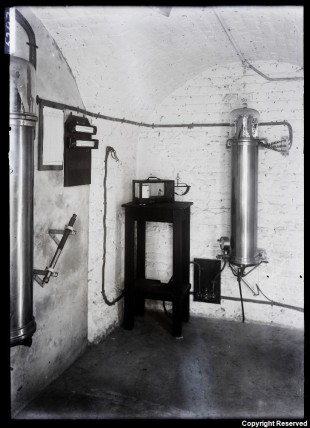
The original Clock Cellar in 1928. The clock on the left is mounted on the east wall and is the Shortt 3 master pendulum. That on the right is on the south wall and is Shortt 11 master pendulum. © BT Heritage. Reproduced under the terms of a Creative Commons Attribution-Non-Commercial-ShareAlike (CC BY-NC-SA) licence (see below)
It was the ability of the wine cellars to provide a reasonably stable temperature together with their massively constructed walls that lead to the Shortt clocks being mounted there.
The cellars however were damp; so before the first clock arrived, steps were put in place to remove it. This was done by rendering the damp walls and taking up the tiles on the North Terrace and relaying them on a layer of six-inch thick concrete. This work was completed by 13 February 1925, but at that point, the cellar was not yet sufficiently dry. A year later, it was still damp, despite ventilation being provided ‘by a four-inch shaft extending to the roof of the building’. Apart from the inconvenience of the dampness and the fact that it was located within the Astronomer Royal’s private apartment and accessed via the Nanny’s kitchen, the cellar proved an excellent location.
The arrival of Shortt 3 and Shortt 11
The first clock to arrive was Shortt No.3. Delivered on 21 November 1924, its free pendulum was set up in the cellar where it was unaffected by the dampness because of its sealed case. The associated slave clock was installed across the Courtyard in the Clock Room at the eastern end of the Meridian Building.
The next clock to arrive was Shortt No.11. It was delivered on 20 May 1926. The free pendulum was set up in the same vault as No.3, but so as to swing in a plane at right angles to it. The slave clock was set up beside that of Shortt 3 in the Clock Room in the Meridian Building. The thick cellar walls were important because they would have minimised the mutual interference that always arises between pendulum clocks when they are mounted together on the same wall.
As designed, the case for the master pendulum came with two brackets, one at the top and one at the bottom; each of which was secured to the wall with two bolts (one on either side). For some owners this arrangement was found to be problematic as differential movements within the wall could cause the vacuum seals to fail and air to enter the evacuated cylinder. This does not appear to have been a problem at Greenwich. In their 1928 paper, Jackson & Bowyer record that in preparation for the mounting of Shortt 11, four holes, each ⅞-inch (22mm) in diameter were drilled through a wall 3 feet 7 inches (1.09m) thick, implying that the bolts passed all the way through the wall.
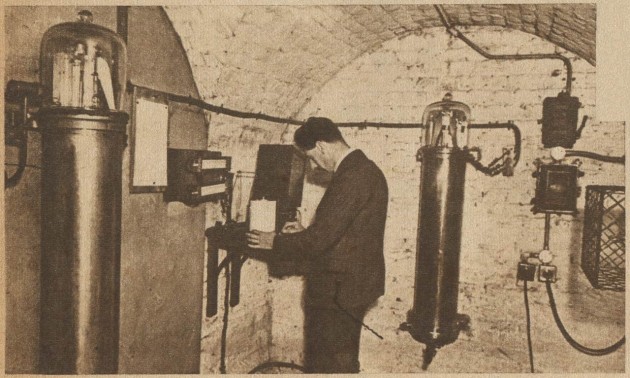
A second wider angle view of unknown (but possibly earlier) date. The person is thought to be William Bowyer who was in charge of the Time Department from 1917 until 1936 when he retired. From the 24 February 1946 edition of Le Patriote Illustré
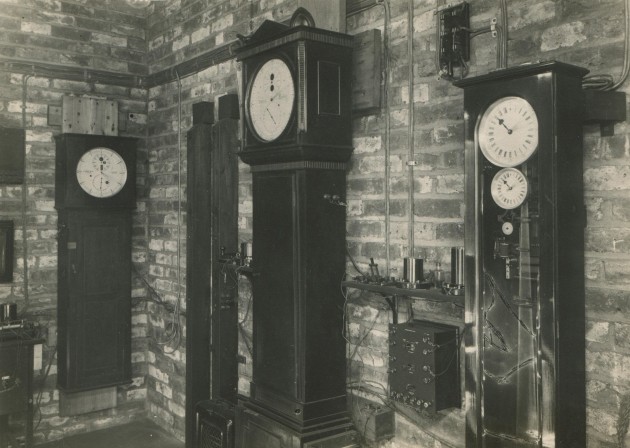
The Clock Room on 7 May 1928. From left to right, the three clocks are: Dent 2016, Dent 2 and the slave clock of Shortt 11. Humphry Smith photographic archive
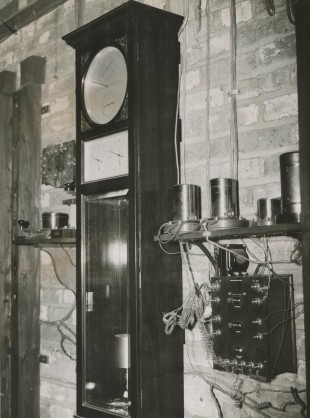
In this photo, taken between 1936 and 1939, Dent 2 has been replaced by the slave of Shortt 40. Humphry Smith photographic archive
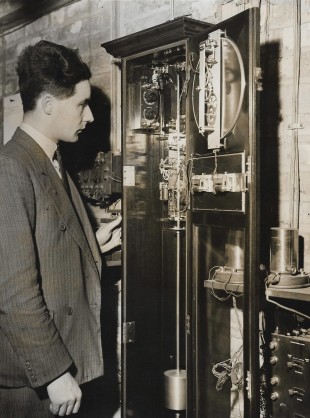
It is seen here with its door open and Humphry Smith standing alongside it. Photo courtesy of Corrine Gadsden
The announcement of the start of the transmission of Rhytmic time signals and the arrival of Shortt 16
The following notice was released by the Admiralty on 26 September 1927 (from Radio Service Bulletin, Washington):
‘It is intended during the month of December, 1927, to inaugurate a service of wireless time signals at Rugby radio station, which will be broadcast twice daily – at 10h. and 18h., G. M. T.
The time signal will be of the modified rhythmic type recommended by the International Time Commission of 1925. It will comprise a series of 306 signals emitted in 300 seconds of mean time (or, alternatively, 245 signals emitted in 240 seconds of mean time), the concluding signal being the exact hour.
In each series, signals Nos. 1, 62, 123, 184 and 245 (and 306, if the series extends for five minutes) are single dashes (-) of 0.4 second duration and commence at the exact minute. Each dash is followed by 60 dots (.) of 0.1 second duration.
The commencement of successive signals, whether dot or dash, are equally spaced at intervals of 60/61 parts of one second of mean time.
The intended procedure will therefore be as follows:
| GMT. | Signal | ||
| m. | s. | ||
| 55 | 00 | 1st signal, a dash (-) followed by 60 dots (.... etc.). | |
| 56 | 00 | 62d signal, a dash (-) followed by 60 dots (....etc.). | |
| 57 | 00 | 123d signal, a dash (-) followed by 60 dots (.... etc.). | |
| 58 | 00 | 184th signal, a dash (-) followed by 60 dots (.... etc.). | |
| 59 | 00 | 245th signal, a dash (-) followed by 60 dots (.... ..etc.). | |
| 00 | 00 | 306th signal, a dash (-). |
This type of time signal will enable chronometer comparisons of extreme accuracy to be obtained, the method employed being to count the number of intervals from the first dash (-) until coincidence occurs between one of the rhythmic signals and the beat of the chronometer. It is not necessary actually to count the signals. Take the nearest second of each dash by the chronometer and write down the chronometer time of coincidence. The difference gives the number of the rhythmic signal,
For ordinary navigational purposes a comparison obtained by disregarding the dots and using the commencement of the dashes only (given at the exact minute) will be sufficiently accurate. Call signal, GBR, wave length, 18,740 meters, c. w.; location (approximately), 1° 11’ W., 52° 22’ N. – Admiralty, London, Notice 1643, September 26, 1927.’
Shortt 16 arrived at the Observatory on 26 October 1927, about a year after Shortt 11 and a month after the above Admiralty announcement (RGO39/5/223). Regulated to mean solar-time it became the mean solar standard. Unlike the two earlier Shortts, it came with an additional slave that beat diminished ½ seconds and generated the rhymic time signal. Together with the Master, the two slaves were set up in the room on the ground floor of what was originally Flamsteed’s eastern summerhouse – the same room that had housed the transit circle chronograph until it was moved in 1914/15 to a newly converted space next to the Airy Transit Circle. Together, their role was to regulate the distribution of radio time-signals – the ‘six pip’ signal transmitted by the BBC and the Rhythmic Time Signals (which were ocassionally referred to as vernier time signals) and to regulate other clocks at the Observatory. Although generated at Greenwich, the rhytmic time signals were transmitted from Rugby, the service commencing on schedule on 19 December 1927. The room in which the clocks were located was initially referred to as the Standard Mean Time Clock Room, but soon became known as the Rugby Room.
The diminished ½ seconds clock had a much shorter pendulum than the regular Slave and ticked at roughly twice the speed, taking a fraction under half a second to swing from side to side instead of a whole second. The idea was, that as it was ticking at a different rate, it woluld be free of liability to beat error. As things turned out, great difficulty was apparently experienced in keeping it properly under the control of the free pendulum (RGO71/1/3/1). As a result, an order was made for a diminished seconds clock to replace it. This was delivered to the Observatory on 2 June 1928, installed in the Rugby Room and presumably brought into service soon after.
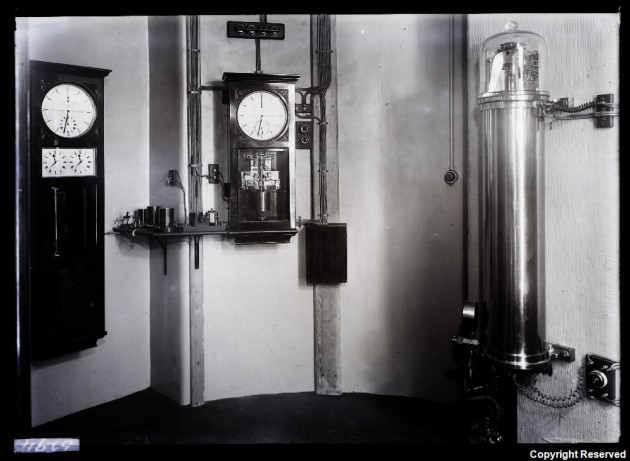
The Rugby Room in 1928. The clock on the left is the slave clock of Shortt 16. It is mounted on the bricked up doorway leading to the North Terrace. The Shortt 16 master pendulum is on the right. It is mounted on the south side of the north pier supporting the Shuckburgh Telescope on the floor above. © BT Heritage. Reproduced under the terms of a Creative Commons Attribution-Non-Commercial-ShareAlike (CC BY-NC-SA) licence (see below)
Image: Internal view of the diminished ½ seconds slave. Photographed 7 February 1928. © BT Heritage. Reproduced under the terms of a Creative Commons Attribution-Non-Commercial-ShareAlike (CC BY-NC-SA) licence (see below)
Image: Two views of the diminished seconds slave. Delivered on 2 June 1928, these two photos were taken by the G.P.O a few months later on 10 September. © BT Heritage. Reproduced under the terms of a Creative Commons Attribution-Non-Commercial-ShareAlike (CC BY-NC-SA) licence (see below)
Spencer Jones alters the access arrangements to the Clock Cellars
On his appointment as the new Astronomer Royal, Spencer Jones was clearly unhappy with the access arrangements to the Clock Cellars; so in 1933, a new entrance opening onto the North Terrace was constructed. This was done by converting the western of the two windows of the room that Airy had used as a larder into a doorway and building a set of steps running down to it in an easterly direction from the Terrace. The steps and entrance have since been removed and the terrace and window reinstated.
The arrival of Shortts 49 and 40 and the relocation of Shortt 16
In 1933/4, the adjoining cellar was converted to house more clocks. Its walls and ceiling were rendered, a new concrete floor and steps were cast and a thick lagged door provided to reduce the leakage of heat. The clocks installed there were: the Master of Shortt No.49 (which together with its slave was delivered in November 1934 as a reserve mean-time clock) and the free pendulum of Shortt No.16, which had previously mounted alongside its slave clock in the Rugby Room, the slave of Shortt 49 being mounted in teh Rugby Room. Shortt No.40 which arrived in 1936 was mounted in the cellar vault housing Shortts 3 and 11. In his book, British Time, de Carle describes visiting the cellars at Greenwich:
‘We enter by way of a few stone steps from the terrace which runs just in front of the residence facing the River Thames … . At the foot of the steps we come to a passage, and a door on the left opens into a small room, with concrete floor and brick walls; on the floor are several small eclectic stoves, controlled by a thermostat, and an eclectic fan to ensure an even temperature. Firmly bolted to the walls, one at each end, are 2 Shortt free-pendulum clocks, but no dials showing the time – they are attached to the slave clocks in another room. … A thermograph, an instrument similar in appearance to a barograph, shows that the temperature has been consistently 68º F. Another door leading from this room opens onto a similar room, similarly appointed, but with 3 clocks. Coming out again onto the terrace and eventually to another small room … we see the 5 slave clocks which are connected to the 5 Shortt free-pendulum clocks just inspected. [De Carle is incorrect here as at the time of his visit, there were three slaves in the Clock Room in the Meridian Building (3, 11 & 40) and two slaves (16 & 49) in the Rugby Room where the diminished second and diminished ½-second clocks were also located.] ’
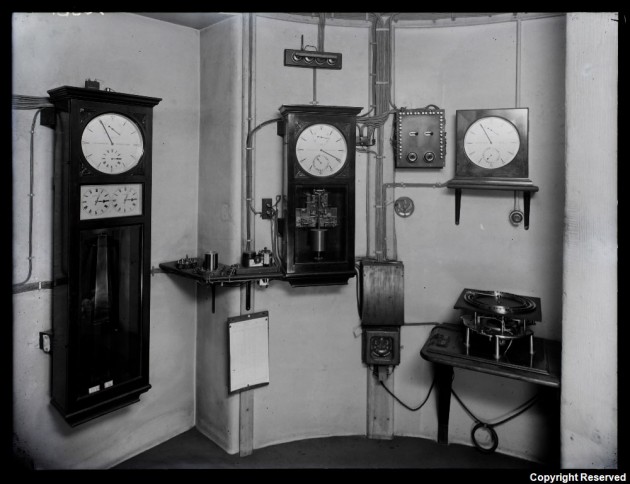
The Rugby Room in 1935. By then, the Shortt 16 master pendulum had been moved to the Clock Cellars. © BT Heritage. Reproduced under the terms of a Creative Commons Attribution-Non-Commercial-ShareAlike (CC BY-NC-SA) licence (see below)
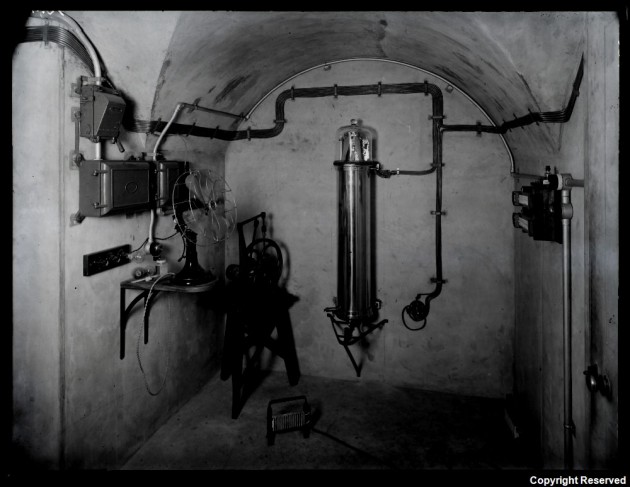
The second Clock Cellar in 1935. The clock is the master pendulum of Shortt 16. It is on the south wall. The handle of the door leading into the cellar can be seen on the right. The passage leading to the inner cellar is on the left. © BT Heritage. Reproduced under the terms of a Creative Commons Attribution-Non-Commercial-ShareAlike (CC BY-NC-SA) licence (see below)
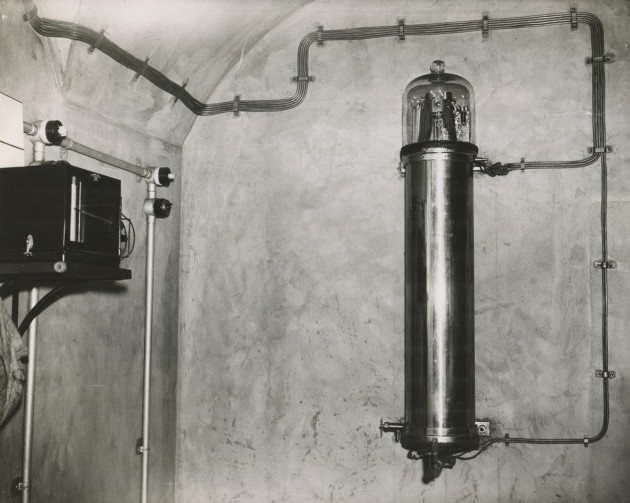
Shortt 49. Like Shortt 16, Shortt 49 was regulated to Mean-solar time. The two clocks were mounted facing each other on opposite walls of the outer of the two interconnecting clock cellars. Humphry Smith photographic archive
Shortt 40
The role of the sidereal clock Shortt 40 was quite different to that of Shortts 3 and 11 as was explained by the Astronomer Royal in his 1935 Report to the Board of Visitors:
‘A generous offer to present to the Observatory a free pendulum installation has been made by Mr. H. R. Fry, F.R.A.S., and has been accepted by the Admiralty. The two sidereal free-pendulum clocks which the Observatory at present possesses are required for routine purposes. One is used as the standard clock; the second is kept available for adoption as standard whenever it may be required. The new clock will not be required for routine work, but will be available for experimental purposes, though it will also serve to improve the accuracy of the time distributed from the Observatory. The need for a third sidereal clock of this nature has often been felt. The new installation will include an improved slave clock, and a special time indicating and distributing clock, in an air-tight case, which will be synchronised by the free pendulum within narrower limits than in the ordinary installations; time will also be taken directly off the free pendulum by a photoelectric method. The specification for the new clock has been prepared.’
In his 1936 Report, he added the following:
‘The construction of this clock, which is being presented to the Observatory by Mr. H. R. Fry, F.R.A.S., is approaching completion. The slave clock is of more refined construction than the standard pattern and is fully jewelled throughout. Experience has shown that the performance of one free pendulum may be consistently better than that of another; thus, the sidereal free pendulum No. 3 performs consistently better than No. 11 and the mean time free pendulum No. 16 performs consistently better than No. 49. Mr. Fry's own free pendulum, No. 40, having given a high standard of performance for 4 years, Mr. Fry has generously allowed it to be used for the new clock. The bob has been repinned to change from mean seconds to sidereal seconds and a steel suspension spring, similar to that in use in Shortt No. 3, has been substituted for the elinvar spring.
Time will be taken directly off the free pendulum by a photo-electric method. The pendulum carries, below the bob, a plate in which there is a narrow rectangular aperture, 1· 5 mm. in width. An image of the filament of a low-voltage lamp is thrown on to a narrow slit by means of a condensing lens. An image of this slit is formed in the plane of the plate on the pendulum by a specially constructed lens, achromatised for λ 7000, the light passing through an optically plane parallel window in the case. A second window is fitted diametrically opposite and the photo-electric cell is mounted behind this window. The current from the photo-electric cell is amplified by a thermionic relay and the output from this relay can be used for the distribution of time. The time of rise to maximum of each signal is one milli-second, this time being determined by the width of the slit; the duration of the signal, about 20 milliseconds, is determined by the width of the aperture in the pendulum plate.
As, with this design, the time taken directly from the free pendulum can be distributed throughout the observatory, the proposed special time indicating and distributing clock is no longer required. This portion of the original plan has therefore been dropped.
A specially designed case is being made for the free pendulum by Messrs. Metropolitan Vickers Ltd. All glass to metal joints will be finished to optical limits and the case will be submitted to the tests customary in high-vacuum technique. For convenience in mounting the optical system, the pendulum will swing at right angles to the wall. The case will be supported by two trunnions, which will be carried by two triangular self-aligning brackets, fixed to the wall. A third bracket, fixed to the wall, defines the position of the lower end of the case. This method of mounting the case was designed by Mr. Shortt.’
The slave clock arrived at the Observatory on 12 May 1936 and the master two months later on 13 July. Later Reports indicate that after various adjustments, the case of the master was finally sealed in October 1936 and the 'photoelectric apparatus, for the purpose of taking time directly from the free pendulum' which was constructed in the workshop had been mounted in position and was undergoing the final adjustments, for centring and focus in April 1937, becoming operational soon after. By April 1939, the photoelectric cell apparatuswas out of action pending the provision of improved relay equipment. No further progress appears to have been made when World War 2 intervened stopping any further development.
Although there is a contemporary image of the slave (see above), there are regrettably no known contemporary images of the master.
The sidereal standard – from single clock to the mean of several
In 1938, the use of a single clock as the sidereal standard for the Observatory was abandoned in favour of taking the mean of all the servicable Shortt clocks at Greenwich, the time on the mean solar clocks being converted to sidereal time for the purpose. These five were supplemented by Shortt 13 from the National Physical Laboratory at Teddington (NPL) and later, Shortt 4, of the Royal Observatory, Edinburgh, signals from both of which were being received on a regular basis at Greenwich.
Wartime: a preliminary overview of the arrangements
In 1937, at the instigation of Humphry Smith, a workshop was set up for the first time at the Observatory for the repair and adjustment of watches and chronometers. This was a strategic move designed to both ensure a high standard of work (at that time the work was being done by commercial workshops whose number and standards were in decline) and a continuity of service should hostilities develop within Europe. As things turned out, World War II began just two years later on 1 September 1939
In his 1945 Report to the Board of Visitors which was completed on 15 May, just a week after Victory in Europe had been declared, Spencer Jones summarised the steps that had been put in place to keep the time-service operational during the war.
'At the beginning of the war, steps were taken to install a skeleton time service at the Abinger Magnetic Station which would provide a service adequate for normal navigational and domestic needs in the event of serious dislocation at Greenwich. A hut was built for a small transit instrument. Two additional free pendulum clocks, Shortt 66 and 67, the latter being equipped for sending rhythmic time signals, were obtained and installed, together with the clock Shortt 61, which was loaned by Mr. H. R. Fry. In the autumn of 1940, the continuous air raids on London made night observations at Greenwich impossible. The entire time service was accordingly transferred to Abinger. As all the time lines from Abinger passed through London and Abinger itself was in a part of the country suffering from air attack, a second time service station became essential. With the co-operation of the Astronomer Royal for Scotland this was set up at the Royal Observatory, Edinburgh, where the transit circle was available for time determinations. Two free pendulum clocks, together with other equipment, were transferred from Greenwich to Edinburgh, and staff from Greenwich was sent to assist in the installation. This was just completed in time to take over control of all signals when the service from Abinger was temporarily put out of action as the result of the destruction of the Central telegraph Office [which was located close to St Paul's Cathedral on the corner of St Martin's-le-Grand and Newgate Street] and the complete severance of all the time signal lines from Abinger. In the intervening period the staff of the Edinburgh Observatory has been engaged almost exclusively on time service work, assisted by one member of the Greenwich staff. The assistance and co-operation of the Astronomer Royal for Scotland and of his staff have proved of the greatest value and have materially helped in enabling a considerable improvement in the accuracy of the time service to be achieved under difficult wartime conditions. With the end of the war in Europe, the time service equipment at Edinburgh will be brought back to Greenwich, as soon as some necessary structural alterations required for its accommodation can be completed.'
For reasons of security, once war had broken out, Abinger was referred to as Station A and Edinburgh as Station B in the Time Service section of the Astronomer Royal's Reports for the years 1940–1944.
Wartime evacuation to Abinger and Edinburgh – the early years
In his 1939 Report to the Board of Visitors, which covered the year 1 May 1938 to 30 April 1939, Spencer Jones informed the Visitors that:
'It has been decided to install at at the Abinger Magnetic Observatory the necessary apparatus for the maintenance of a subsidiary time service which could take over, whenever required, the more essential duties of time signal distribution normally carried out from Greenwich. The transit instrument D, which had been used in connection with the personal equation machine, has been mounted there, and pending the provision of additional equipment, the Dent clock formerly used as the sidereal standard clock at Greenwich [Dent 1906] and the mean time Dent regulator 2016, previously kept as reserve time signal transmitter, have been erected in the old battery room, which was cleared and partitioned to enable a reasonable temperature control to be maintained. Temporary chronograph equipment has also been installed.'
When war boke out in September 1939, two further Shortt Clocks were ordered from Synchronome in order to beef up the provision at Abinger.
In a confidential appendix to the 1940 Report (which covered the period up to 30 April that year) Spencer Jones wrote:
'In the early days of the war, an ad hoc time-service was set up at the Magnetic Observatory, Abinger. This was intended to supply a time-service of a somewhat lower order of accuracy than that provided from Greenwich, with hourly signals to the Post Office for the control of the Talking Clock and for other purposes and with quarter-hour signals to the B.B.C. The generous loan by Mr. H.R. Fry of his Shortt mean-time free-pendulum clock [Shortt 61] (which has been converted to a sidereal standard), a long wave radio-receiver and a tape chronograph made it possible to have a skeleton time-service available within a few weeks of the outbreak of war.
A complete time-service has now been installed at Abinger which will be able to take over all the functions of the time-service from Greenwich, including the sending out of the Rugby rhythmic time-signals, with about the same accuracy. A permanent housing for the small-transit instrument has been erected. It is planned to operate the time-service from Abinger whilst the change-over of all the time circuits to the new terminal board is being made, in order to try out the service. (ADM190/19)
The 'complete time-service', included the two new clocks: Shortt 66 (sidereal) and Shortt 67 (mean solar with a regular and a diminished seconds slave), which were delivered on 26 February 1940 and were were presumably set up alongside Dent 1906, Dent 2016 and Shortt 61 in the old battery room. At the time of the Report, steps had also been taken towards the modification of Dent 2009 so that it could act as the transmitting clock for the six pips at Abinger in place of Dent 2016, which at that time it was planned to return to Greenwich as the reserve to Dent 2012.
The confidential appendix ended with a warning about the vulnerability of Greenwich and Abinger and the steps that had been put in hand to case both were put out of action at the same time:
The Post Office lines from both Greenwich and Abinger pass through the Control Room at the G.P.O. London. If this room were put out of action, time-signals could not be distributed from either Greenwich or Abinger. Arrangements are in train for sending signals via Birmingham; meanwhile, arrangements have been made with the Astronomer Royal for Scotland by which time-signals (with the exception of the Rugby rhythmic signals) can be sent from the Royal Observatory, Edinburgh, whenever this should prove necessary.' (ADM190/19)
What Spencer Jones did not say (at least not in writing), was if this vulnerability had been known from the start, or if it had only been discovered after the setting up of the time-service at Abinger had begun.
In his next Report (1941), Spencer Jones was to write:
'The determination of time and the distribution of time signals from Greenwich was continued until September [1940, when the Blitz began]. The continuous all-night air raids then made night observations impossible and the service was accordingly transferred to the emergency station A [Abinger]. For some weeks[,] time observations were made at this station whilst time signals continued to be sent out from Greenwich. The transmissions from Greenwich were finally terminated towards the end of November and all signals have since been sent out from the emergency stations.'
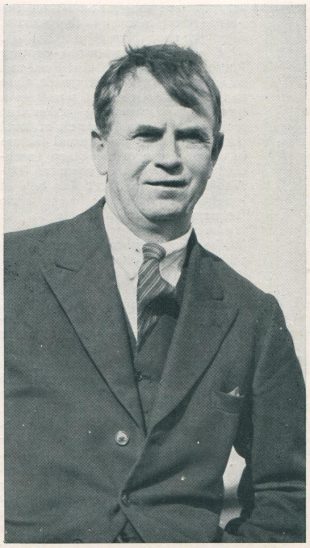
William Greaves, Chief Assistant at Greenwich (1924–1937) and Astronomer Royal for Scotland (1938–1955). From an article announcing his appointment as Astronomer Royal for Scotland
Greaves fills in some of the details in his Report for the period 1940 December to 1945 April:
'By the end of December [1940] the work of installation had fortunately been carried to a point which allowed the transmission of rhythmic signals to Rugby, and as a result the Observatory was able to operate the Rugby signals, although under difficult conditions, in 1941 January when, in consequence of enemy action [the destruction of the Central telegraph Office which was set alight by burning debris from adjacent buildings and the complete severance of all the time signal lines from Abinger], it was impossible to operate this service from the Greenwich station at Abinger. At the same time the work of installation proceeded. From 1941 May to 1943 March 29 and from 1943 October 27 to the present date the rhythmic signals radiated from Rugby at 10h U.T. were normally operated from Edinburgh, but originated from Abinger on a few occasions when, owing to technical faults, transmissions from Edinburgh were not possible or advisable. A large number of the Rugby transmissions at 18h U.T. and of the transmissions from British short-wave stations (which were commenced in 1942 July) have also been operated from Edinburgh. On a few occasions the Observatory has been called upon to operate the B.B.C. “six-pips” signals. Hourly signals to the Post Office have been supplied and have been available for the control of the “speaking clock”.'
Quartz clocks, for rhythmic signal from 1944.
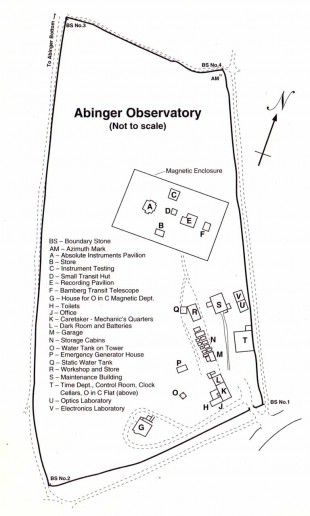
Post war plan of the Abinger site. The Shortt and Dent clocks of the Time Service were housed initially at location L and from 1942 until about 1950 in the specially constructed building marked S. S also housed the quartz clocks until a later new building T containing the clock cellars became available towards the end of 1944. Image courtesy of Peter Tarplee
'A building has been erected at Time Station A to provide suitable and adequate housing for three Shortt free-pendulum clocks and for the quartz clock, with a minimum expense and labour. It consists of two separate clock chambers, inside a main brick and concrete room, approximately 25 square feet in area. The outer room is heated by hot-water radiators, the clock chambers being electrically heated, with thermostatic control. The slave clocks and ancillary equipment will be installed in the outer room. Progress on the building, which has now been completed, was slow; the installation of the necessary wiring, preparatory to the erection of the standard clocks, is in hand.'
It was not until November 1942 however that the new clock room was ready. In his 1943 Report, Spencer Jones records:
'The free pendulum clocks Shortt 40 and Shortt 49 [which had presumably been out of service since the transmission of time signals from Greenwich ceased at the end of 1940] were erected in the new building at station A in November and Shortt 66 was transferred from the old clock room [at Abinger] in December. The quartz controlled frequency clock Q3, previously installed at Greenwich, was overhauled at the National Physical Laboratory and re-erected in the new building in January [1943].'
Wartime evacuation to Abinger and Edinburgh – Quartz clocks begin to oust the Shortts
Quartz clocks had been under development for a while and showed every sign of being superior to the Shortt Clocks. Greenwich's first Quartz Clock (which was built for it by the National Physical Laboratory) and ordered in 1936/7 was delivered on 11 April 1939 and installed in a specially prepared cellar at Greenwich under the Ball Lobby in Flamsteed House. With the outbreak of war, development work with the clock came to a halt and the clock mothballed.
Spencer Jones ended his 1940 Report with the following statement:
'The further improvement in accuracy of the time service provided by the Observatory has been under consideration. For purposes where high precision is needed, corrections to the time signals are published at approximately monthly intervals, after the errors of the mean clock have been satisfactorily determined from a large number of observations. The great developments in recent years in precision frequency standards and in their use have created a need, which is extending rapidly, for time signals of such precision that an interval of 24 hours can be measured to an accuracy of one thousandth of a second, without the application of corrections published after a considerable interval. This precision is not attainable with pendulum clocks, which are less accurate than the precision frequency standards themselves. The installation of a battery of quartz crystal oscillator clocks of the highest precision is required, in order that the frequency stability of modern frequency standards may be satisfactorily controlled. Conferences on this subject have been held with the Radio Section of the General Post Office and the Research Department of the British Broadcasting Corporation. The help and collaboration of these bodies and also of the National Physical Laboratory are greatly appreciated and should go far towards enabling a satisfactory scheme to be drawn up.'
By April 1942, the published corrections to the times of the Rugby time-signals and to the foreign time signals were based on some or all of nine clocks: seven Shortt clocks and two Quartz clocks. The re-emergence of Q3 at Abinger marked a rapid acceleration in the introduction of Quartz technology into the time-keeping service and the beginning of the end for the Shortt Clocks.
In his 1943 Report Spencer Jones went on to say:
'A fundamental change in the operation of the Time Service, which has affected not only the preparation of final corrections but also prediction methods and reception technique, has been brought about by the fuller use of clocks of the quartz-controlled frequency type. Comparisons between clocks of the free pendulum type, of which there are ten available, and quartz clocks, of which there are at least six available, show the undoubted superiority of the latter. Pendulum clocks appear to be subject to a more or less continuous accidental change of rate, and the integration of these changes produces “wandering”. Quartz controlled clocks on the other hand are subject to changes of rate which are definitely recognisable and may in extreme cases be large, but the epochs, and to a large extent the amounts of these, may be detected by intercomparisons between the quartz clocks themselves. In addition they may be subject to a continuous accidental daily change of rate, which would by integration produce wandering; such erratics, if they exist, are certainly much smaller than in the case of pendulum clocks.
In the transmission of time signals it is necessary, both for prediction and for the preparation of final corrections, to determine the errors of a clock by drawing a smooth curve through points on a chart representing its errors as indicated by transit observations. Any attempt to deduce the daily errors of a pendulum clock in this manner is bound to lead to a smoothing of the real wanderings of the clock owing to the scatter in the transit observations due to inherent and inevitable errors of observation. The complete disappearance of clocks of the free pendulum type from the group used in the determination of final corrections has been gradual, Shortts 4 [Edinburgh], 13 [NPL] and 16 [Edinburgh] having each for periods of some months put up a very fine performance, but it at last became apparent that the inclusion of even the best of these was of no value in smoothing out such irregularities as may have been present in the quartz clocks themselves, or may have been introduced by the methods of intercomparison, since the pendulum clock might itself have introduced greater errors.
At present the quartz controlled clocks are mostly situated at institutions other than the two time service stations but, by using the comparisons based on the 10.00 hour Rugby signals, transit observations of the errors of the observatory clocks may be transferred so as to give determinations of quartz clock errors. In view of the undoubted superior performance of these clocks, a fairly drastic smoothing process can then be applied to the individual determinations of clock error, and reliable values for quartz clock errors thus obtained in which the accidental errors of transit observations have been to a large extent eliminated by meaning. Since the Observatory clocks can be compared daily with the quartz primary standards, again through the medium of the Rugby signals, their daily errors can be deduced. The procedure therefore has been to base the time service fundamentally on quartz clocks available at other institutions and to use the Observatory clocks as intermediary substandards for extrapolating the time as given by the quartz standards over 24 hours. For this extrapolation process, free pendulum clocks are singularly ill-suited. It is thus a matter of pressing urgency to replace the existing free pendulum clocks by quartz clocks at the time service stations, so that quartz primary standards can be used to control the service direct. ...
The urgent need for precision quartz clocks should be alleviated to a limited extent by the delivery towards the latter part of 1943 of three clocks of the Post Office group 4 type. These clocks are now under construction by the Post Office Radio Department and it is proposed to equip two of them, one for each time service station, with phonic motors carrying gearing to enable them to be used as rhythmic signal transmitters. The present transmitting clocks, which are of the slave clock type, suffer from many defects such as irregularity of contacts and wandering of phase and their replacement is a matter of urgency. All three oscillators will be of the highest possible stability and will therefore be equally valuable as standard clocks. The assistance of the Post Office in placing their experience and facilities at the disposal of the Observatory in this matter is greatly appreciated. It is apparent however that the provision of two quartz clocks at one station and one at the other is only a step towards the inevitable replacement of the pendulum clocks by groups of quartz standards.'
In his 1944 Report Spencer Jones informed the Board that:
'The 10h Rugby signals are normally controlled from the station at which the transmitting clock and the line to the radio station were the more stable; the 18h signals are controlled from the station that acts as reserve for the 10h signals. The first phonic motor transmitter to be received was installed at station B, and was brought into use almost immediately for the control of the rhythmic time signals. The 10h signals have been operated from phonic motors since 26th February 1944 and the 18h signals from 10th March. The introduction of phonic motor transmitting clocks has provided accurately spaced signals. The irregularities in the spacing of the signal dots from the pendulum transmitters previously used was such that it was necessary to measure identical sets of signals in the five minute series at the two stations in order to separate the discrepancies arising from irregular spacing of the signals from the erratics of radio reception and measurement. This expedient permitted more accurate comparisons between the two stations, but did not assist other users of the signals. A more serious source of error in the pendulum transmitting clocks was their tendency to wander by an unpredictable amount after they had been set and checked, thus putting the signals in error by an amount that might be as large as five milliseconds; the high short-period stability of the quartz controlled phonic motors has reduced such errors to negligible amounts. ...
The time service is still being based fundamentally on the comparisons between the transit observations and the Post Office group IV standards ...
Some of the free pendulum clocks have been stopped; others, that have been left running, are not regularly compared. As time signals are required to be transmitted at definite mean times, the fundamental time standards for time service purposes are rated to mean time. Clocks rated to sidereal time are required only for comparison with transit observations, where the use of meantime clocks would be inconvenient. A number of free pendulum clocks and also the quartz clock Q3 at station A [Abinger] are used for this purpose but, by means of comparisons with the mean time standards taken immediately before and after each time observation, the observed clock errors are transferred to the mean time standards. Phonic motors now under construction are being provided with gearing which will operate contacts every sidereal second and every mean time second, when the motor is driven by a mean time standard. An exact gearing is not required; an approximate ratio merely introduces a small uniform rate into the sidereal clock thus made available for transit observing. ...
Amongst the clocks taken out of service was the Shortt 66 master and its slave. They were subsequently mounted on wooden exhibition stands and used as a prop for the 1944 Royal Institution Christmas Lectures that Spencer Jones had been invited to deliver. Click here for a video clip.
The small reversible transit B remained in use at Greenwich until observations ceased. From October 19, it replaced instrument D at the emergency station [Abinger].
War time history of Shortt 3
Shortt 3's war-time history is somewhat obscure. Unlike the other Shortts, its location during the war years was never recorded in the Reports which did however include the following:
1940: 'Shortt 3 was fitted with a new impulse wheel and bracket on August 3 [1939] and the weight tray was turned down to compensate for the additional weight of the new bracket. ... Shortt 3 was opened on February 1 [1940] for cleaning the contacts, and was again opened on April 24 [1940] for resealing. ... The chronograph and sidereal time circuits of the Observatory were operated by Shortt 3 until July 31, since which date they have been controlled by Shortt 11.'
1943: 'The photo-electric cell equipment for Shortt 40 is being redesigned and a new case for Shortt 3 has been obtained so that this may be similarly equipped. [Interestingly, the new case is not listed amongst the items added to the inventory at the 1943 meeting]. ... The present standard of accuracy calls for the elimination of existing pendulum clocks from the operation of the time service at the earliest possible moment, but only experiment can show whether the best free pendulums would be worthy of retention provided a photo electric method of taking the time directly off the free pendulum were employed.'
1945: 'Two years ago, it was reported that photoelectric equipment was being fitted to a Shortt master clock. This work was shelved for a time for more urgent work, but some progress has been made. After a careful series of experiments to determine the optimum slit widths for the primary and secondary slits, the tolerance of focus, a means of focusing with suitable accuracy, the requisite degree of stability of the light source, and other details, an experimental optical system was constructed and has been tried out. One of the most serious difficulties has been the insufficiently rigid mounting of the clock, and it is hoped to try the system out with a clock mounted on a more stable support. It also became quite apparent that further refinement in the method of taking the time from the pendulum was of little value unless some improved method of impulsing the pendulum could be developed. Preliminary experiments have been carried out on a method of electrostatic impulsing, but little can be said except that it is possible to maintain the arc by this means. Further work on this subject is required, but for the present it is not of vital importance and is only receiving attention when more important work permits. The electronic unit for the impulsing has been completed, and also a pulse unit for operating from the photoelectric cell timing device.'
Clearly still at Greenwich at the end of April 1940, the 1943 Report implies that it was transferred at some point to Abinger. However, despite the fact that there is no record has been found showing that Shortt 3 was ever at Edinburgh the 1946 Report states: 'The Shortt clocks 3, 11, and 16, which were in use at Edinburgh, have been cleaned and overhauled, and will be re-mounted at Greenwich.' This inclusion of Shortt 3 in this statement is believed to have been made in error is discussed in more detail below.
Post war history of the Shortts at Greenwich and Abinger
At the very end of his 1945 Report, Spencer Jones informed the Visitors that:
'Abinger will remain for the present the main time service station of the Royal Observatory. There is no space on the restricted site at Greenwich for the time service installation at Abinger. When a new site has been obtained for the Royal Observatory, the portion of the time service at Abinger will be transferred to the new site. Observations both at the new site and at Greenwich will then require to be continued for a sufficient period to enable the longitude of the new site to be determined with accuracy.'
In his 1946 Report, Spencer Jones he informed them that the equipment spread across the two clock rooms at Abinger had been consolidated into one.
'All time service equipment has been removed from the two rooms previously used [at Abinger] by the Magnetic Department as an engine room and battery room, which were adapted at the beginning of the war to provide a skeleton time service, in the event of interruption of the service from Greenwich. These rooms are being converted for use as dark rooms and for housing the continuous film developer and other equipment, needed for the increasing use of photographic and film technique in. the time service. The Dent regulator used for the B.B.C. and Post Office signals has been removed to the main clock building [the one built in 1942], and placed under the control of Shortt 49. The various clock circuits, which previously terminated in the engine room, have been transferred.'
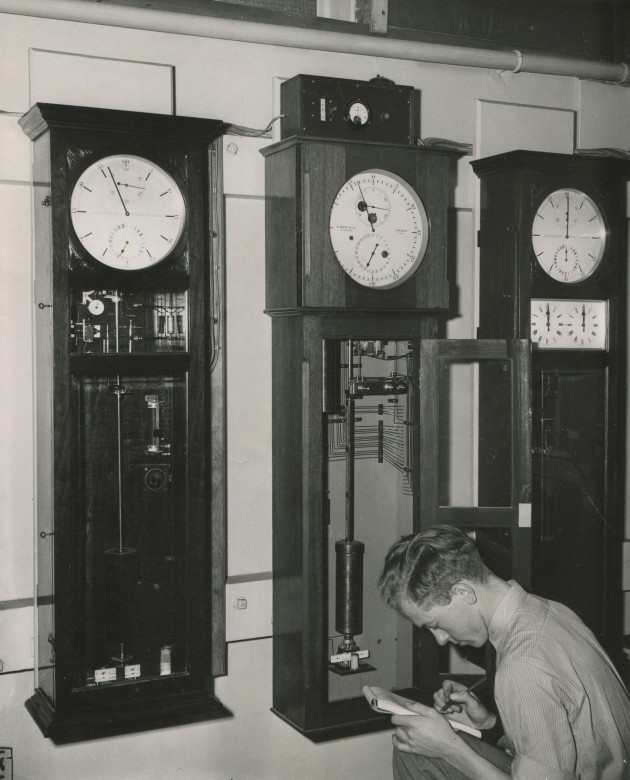
The outer of the two new clock chambers erected at Abinger in 1942 (building S in the plan above). From left to right, the clocks are: slave of Shortt 49; Dent 2012; diminished seconds clock (stopped) of Shortt 67. Thought to date from 1950, the picture features Assistant Experimental Officer, Peter Lamb. Humphry Smith photographic archive
Click here for a wider angle view from September 1946, which additionally shows the slave of Shortt 40 (on the left).
He then went on to say:
'A secondary time service station is being installed at Greenwich. This station will provide a reserve time service, while the main station remains at Abinger. During the period of transfer of the time service equipment from Abinger to the new site for the Royal Observatory, it will take over the full duties of time service operation. On the completion of this transfer, time determinations will be continued at Greenwich for the period required for an accurate determination of the longitude of the new site [Herstmonceux].
The Shortt clocks 66 and 67, previously mounted at Abinger, have been thoroughly overhauled and have been remounted [at Greenwich]. Shortt 61 has been returned to Mr. H.R. Fry, who had generously loaned it to the Royal Observatory for the duration of the war. One of the Dent Regulators [Dent 16] from Abinger has been fitted with new contacts, and installed at Greenwich, under the control of Shortt 67, for the emission of the 6-dots time signals for the British Broadcasting Corporation, and of the hourly signals to the Post Office for the control of the Speaking Clock and of other services. These signals are available from Greenwich as a reserve in the event of any failure of the signals from Abinger. The covering of the Altazimuth Dome; which was destroyed when the building was hit by a bomb, has been renewed, in preparation for installing a small transit instrument for time determinations.'
A photo taken by George Rodge in 1946 indicates that Shortt 67 was mounted in the clock cellars where Shortt 16 had been mounted previously. Tucker confirms that it was mounted in the outer cellar and also records that Shortt 66 was mounted there too, presumably in the position previously occupied by Shortt 49 (RGO71/1/3/1).
Earlier in the same 1946 Report the Astronomer Royal had told the Board that:
'The time service station at the Royal Observatory, Edinburgh, was maintained in operation, on a gradually reducing scale, until the end of January, when the equipment was dismantled and returned to Greenwich and Abinger. The Shortt clocks 3, 11, and 16, which were in use at Edinburgh, have been cleaned and overhauled, and will be re-mounted at Greenwich.'
Spencer Jones appears to be in error here. No evidence has been located to suggest the Shortt 3 was ever sent to Scotland. Quite the opposite in fact as is indicated by the following sources:
- the modification of Shortt 3 in 1942/3 indicated in the section above
- the 1941 Report, states 'The Shortt mean time clock No. 16 and sidereal clock No.11, together with Rugby diminished seconds transmitter, have been transferred from Greenwich and mounted at this station [Edinburgh]'
- The 1945 Report of the Astronomer Royal for Scotland's which states that the equipment sent from Greenwich included 'the Free Pendulum Clocks Shortt Nos. 11 and 16', going on to say: 'During 1942 and 1943 some investigations were carried out on the erratics of free-pendulum and quartz clocks, the results being published in a paper by Greaves and Symms (M.N., 103, 196—the free-pendulum clocks designated X, Y and Z in this paper are respectively Shortt 4, Shortt 11 and Shortt 16)'. If shortt 3 had been at Edinburgh, it would surely have been included in the study.
In the event, rather than being remounted at Greenwich, most of the clocks appear to have been put into store instead. According to the List of Pendulum Clocks of the Royal Observatory Greenwich compiled by Roy Tucker in 1954 (RGO71/1/3/1), when a check was carried out in October 1948, these clocks were distributed as follows:
| Shortt 3 | Master | Mounted and idle in L.H. clock chamber at Abinger | |
| Slave | Mounted and going in Rugby Room at Greenwich | ||
| Shortt 11 |
Master | Stored at Greenwich | |
| Slave | Apparently sent to Cambridge in 1946 | ||
| Shortt 16 |
Master | Some parts stored at Greenwich, but other parts at Cambridge | |
| Slaves | Stored at Greenwich |
The establishment of a reserve time service at Greenwich
Photographic evidence indicates that Shortt 67 was mounted in the clock cellars where Shortt 16 had been mounted previously.
Shortt 40 & 49 as time standards at Herstmonceux
Although the formal acquisition of the new site for the Observatory at Herstmonceux was completed in 1947, it took a further ten years before the the time Department was ready to move in. It was the last Department to do so. By contrast, the Chronometer Department was the first, taking possession of its temporary workshop in the wartime hutments in September 1948. Although it needed a precision time standard, it had to wait until 1950 for one to be provided.
Around the same time, work began on erecting the first of the new buildings, which had been designed to house the Dallmeyer photoheliograph, which was being used at Greenwich. The Chronometer Department being in need of a precision time standard, Spencer Jones told the Board of Visitors In the Report he delivered to the Board of Visitors that June, he wrote:
'A start has also been made with the Solar Building [for the photoheliograph] ... It is planned to mount a Shortt master pendulum on the main pier; although this will not be thermostatically controlled, it will serve to carry the time between radio signals, and will in fact be the nearest approach to a precision standard at Herstmonceux for some years.'
Despite the fact that building work was still ongoing, the building became operational on 2 May 1949 when the photoheliograph was transferred from Greenwich. As far as is known, a Shortt Clock was never installed on the pier.
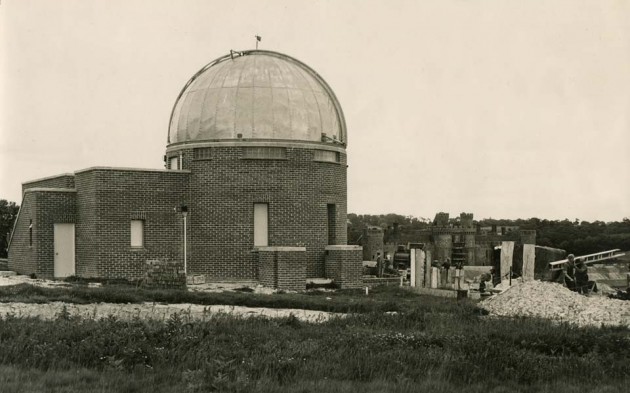
The Solar Dome at Herstmonceux in 1949. The two piers at the front of the building are on the south side and were built to support the coelostats of the Greenwich and Newbegin spectrohelioscopes which were installed the following year
Instead, a temperature controlled clock room was created in one of the cellars in the Castle. In his 1951 Report, Spencer Jones wrote:
'The Shortt Free Pendulum No. 40 with its precision Slave Clock has been mounted in a temperature controlled clock room under the West courtyard to provide a more accurate time standard. A mean solar dial is now operated in the Solar dome and an hourly signal is transmitted to the Solar Office to afford a reliable time base on the recorder for the Sudden Phase Anomaly Indicator.'
In 1954, Shortt 49 was transferred to the Department. In his 1955 Report, Spencer Jones informed the Visitors as follows:
'The sidereal Free Pendulum Shortt No. 40 has been in use continuously as the standard in the Department, being checked daily against the Rugby Rhythmic Signals. In November 1954 the Free Pendulum Shortt No. 49 rated to solar time was mounted in the clock cellar and brought into use as the solar standard, distributing seconds impulses to the dials in the chronometer rating rooms, the time signal reception room and the Cosmic Ray Laboratory. Hourly signals are sent to the Solar and Meteorological Departments for the calibration of recording apparatus.
Before being mounted at Herstmonceux the free pendulum and slave movements of Shortt No. 49 were overhauled, the- slave being fitted with Ritchie contacts in lieu of the original synchronome switch.
Irregularities in the daily rates of the two standard clocks, at first attributed to instability of the Castle wall on which they are mounted, were eventually traced to fluctuations of the temperature in the clock cellar. Observations of the daily rates compared with the Rugby signals when the temperature of the cellar was changed by 5°C indicate a temperature coefficient in the rates of both clocks of approximately 0.03s per 1°C, which appears to be much larger than the figures obtained from the earlier Shortt clocks. Attempts have been made to reduce the coefficient but little change has been effected to date.'
Shortts 40 & 49 remained in use by the Chronometer Department until the time distribution system at Herstmonceux was finally completed around the end of 1960 (RGO9/300).
The end of an era
The use of the Shortt Clocks as time standards that had begun in 1925 was ended less than 25 years later, in 1949, with the transfer of the G.P.O. and B.B.C. signals from Dent regulators, under the control of Shortt clocks, to phonic motors, under the control of quartz clocks.
Loan of Shortts 66 and 67 to the Cape and the sending of Shortt 10 to Herstomonceux
1959. Two Shortt F.P. clocks and a Dallmeyer Equatorial Mount have been sent to the Cape.
When the Observatory left the site at Herstmonceux for Cambridge, one of the objects that seems to have been left behind was the cylinder from Shortt 10, a sidereal clock that had been supplied to the Cape Observatory in March 1926, just before Shortt 11 had been supplied to Greenwich. Painted blue (which was the standard Cape Observatory colour), it is now in the collections of The Observatory Science Centre. Click here to view. There is no information available as to what happened to the rest of the clock.
The sale of Shortts 11 and 49 to the Perth and Sydney Observatories
Two Austrailian observatories, Melbourne and Sydney were amongst the earliesty adopters of Shortt Free Pendulum Clocks, ordering sidereal versions in August and December 1925 respectively. The two clocks supplied were Shortt 5 and Shortt 8. Melbourne ordered a second sidereal clock in 1936 (Shortt 59). The Perth Observatory came late to the party, acquiring its first clock, Shortt 94 (mean-solar), in 1957. The clock was one of the last to be made.
In 1957, The Sydney Observatory sought to borrow a Shortt Clock from the Royal Observatory. In the past, the Observatory had both lent and borrowed equipment with no apparent difficulty, though on whose authority such arrangements were made is unclear. In this case, we know that Wolley consulted the Hydrographer of the Navy, Rear Admiral Kenneth Collins, to whom he reported. It would seem that Collins asked him for futher details including its value. Wooley replied on 14 June 1957. Writing to Wolley on 24 June, Collins responded: 'I fear that we shall be unable to obtain sanction for such a loan for an unspecified period as in the view of the authorities, this connotes a gift of the value of £500'. He went on to suggest that a clock could be lent for a specified length of time of say five years with depreciation charges waived, but not any liability for loss damage or deterioration not due to fair wear and tear. No loan was made.
In 1959, Hyman Spigl, Director of the Perth Observatory and Government Astronomer of Western Australia visited Hersmonceux. When during his visit, he asked about borrowing any of the Shortt Clocks, he was informed that Sydney's request had been previously turned down.
Despite this, on 9 February 1960, the Perth Observatory made a formal approach through the Office of the Agent General for Western Austrailia for the loan of two Shortt clocks.
The information in this section is taken from the incomplete notes and correspondence filed in RGO/9/300 relating to the supply of the clock to Perth. It includes some references Sydney including a photocopy of one of the letters from 1957. No separate file has been located in the catalogue relating to the Sydney transaction.
The 1960 request from Edinburgh for the use of a clock
The painting of the copper cases of some of the Master Clocks
Today, most of the seven master clocks once owned by the Royal Observatory are believed to have had their copper cases painted. All the known contemporary photographs taken in or before 1946 appear to show the cases in an unpainted and shiny state, suggesting that the painting occured after 1946. Based on the appearance of Shortt 7 in 2008, the cases of the Greenwich Shortts are likely to have become similary dull and tarnished over the years, giving them an appearance to the uninititated of being unloved and uncared for. It is suspected that the painting probably took place at Herstmonceux, being applied in the chronometer workshop to clocks that were either sent out on loan or being sold.
| Serial Number | Colour | comment | |
| 3 | Pale grey | Standard Royal Greenwich Observatory colour** | |
| 11 | ?* | ||
| 16 | Clear lacquer | Possibly as requested by the National Maritime Museum | |
| 40 | Mid Grey | Standard Royal Greenwich Observatory colour | |
| 49 | Grey | Possibly the same grey as Shortt 3 | |
| 66 | Blue | Standard Cape Observatory Colour | |
| 67 | ?* |
* It seems likely that Shortt 11 was painted grey and Shortt 67 blue. Confirmation of this is currently being sought
** Different shades of grey seem to have been used at different time for painting the telescopes and other equipment
It seems likely that the painting had an impact on the how the clocks rate would change as the temperature of the space in which it was mounted changed as the paint's insulating proerties would have slowed the rate of transfer of heat to or from the pendulum and therefore the rate at which its length changed.
Detailed history of the clocks
In their Reports to the Board of Visitors, both Dyson and Spencer Jones gave updates on the status of the Time Service and the various clocks. The relevant sections have been transcribed and can be read here. A text search for the word Shortt will highlight the places where they are mentioned.
Extracts from the Reports of the Astronomer Royal relating to the Time Service (1937–1964)
Further notes on individual clocks
Working notes
The following extracts are taken from the Reports of the Astronomer Royal.
1950: The free pendulum movement (Shortt No. 16) and its slave clock were cleaned prior to being loaned to the Cavendish Laboratory of Cambridge University.
The transfer of the G.P.O. and B.B.C. signals from Dent regulators, under the control of Shortt clocks, to phonic motors, under the control of quartz clocks, concluded the history of the long and useful service rendered in the operation of the Time Service by the Shortt Free Pendulum clocks.
1951: In addition to the normal repair work the Cooke regulator from the Solar Dome, the Shelton regulator from the Abinger Magnetic Station and the Free Pendulum and Slave Clock (Shortt 40)
1952: In addition to coping with additional repairs to chronometers and watches, the chronometer workshop has, during the year, overhauled and cleaned the Free Pendulum movement Shortt No. 49 and the Dent regulator No. 2012 at Abinger; the modification of the second La Cour with magnetometer at Abinger Was completed.
1953: The Shortt Free Pendulum No. 40 used as the time standard in the department has been running throughout the year and has been checked daily against the Rugby Rhythmic Signals. The daily rate of the clock is accurate to about ± 0.015s from the mean rate, but the clock appears to have a large temperature coefficient and to be subject to periodic changes of rate without apparent cause.
1954: The sidereal Free Pendulum Shortt No. 40 used as the standard in the department has been running throughout the year and has been checked daily against the Rugby Rhythmic Signals. A subsidiary clock keeping solar time is corrected as necessary, after comparison with the sidereal standard, and signals are distributed to the chronometer rating rooms and also to the Solar, Magnetic and Cosmic Ray departments for the calibration of recording apparatus.
Shortt 49 free pendulum and slave have ‘been dismantled and transferred to the Chronometer Department at Herstmonceux.
As indicated by Spencer Jones, the master was then mounted in the outer clock cellar at Greenwich (previously used for the mean-time Shortts) and used not with the Shortt 66 slave, but with the slave of Shortt 3, which was mounted not in the Clock Room at Greenwich (as before), but in the Rugby Room instead. The slave of Shortt 66 was transferred on its wooden stand from Greenwich to Abinger in 1948 for use in lectures.
Contemporary videos
Scientists of tomorrow. British Pathe, issued 19 Feb 1945. Several shots of Astronomer Royal Sir Harold Spencer Jones delivering the 1944 Christmas Lectures (Astronomy in our daily lives) to young science students at the Royal Institution. Short 66 can be seen mounted on an exhibition stand in the background.
Further reading
The Free Pendulum. F. Hope Jones, Journal of the Royal Society of Arts p.446–460 (23 May, 1924). Alternative link.
The Shortt Clocks at the Royal Observatory, Greenwich. J Jackson & William Bowyer, MNRAS Vol 88, pp.465–481 (1928)
The Shortt Clocks and the Earth's rotation. J Jackson & William Bowyer, MNRAS Vol 89, pp.239–250 (1929)
The Shortt Clocks at the Royal Observatory, Greenwich with special reference to the effect of the variation of arc. J Jackson & William Bowyer, MNRAS Vol 90, pp.268–278 (1930)
A contemporary account of the Time Service and Department from 1923 to 1948 by the Astronomer Royal, Harold Spencer Jones
International Coordination and Atomic Time. Humphry M. Smith, Vistas in Astronomy Vol 28, pp123–128 (1985)
Electrical Timekeeping. Frank Hope-Jones (1940)
Synchronome - Masters of Electrical Timekeeping. R.H. Miles (2019), pp. 27–30, chapters 8 & 9 and appendix 2
The Earth As A Clock, being the Halley Lecture delivered on 5th June 1939. Harold Spencer Jones (1939)
The Determination of Precise Time. Sixteenth Arthur lecture, given under the auspices of the Smithsonian Institution. Harold Spencer Jones, (14 April 1949)
On the cause of discrepancies in time-determination. R.A. Sampson, MNRAS (1925) Vol. 85, pp.560–568
Quartz clocks of the greenwich time service. H. Smith, MNRAS (1953) Vol. 113, pp.67–80
Image licensing
The photographs marked © BT Heritage were obtained from The BT Digital Archives and are reproduced under the terms of a Creative Commons Attribution-Non-Commercial-ShareAlike (CC BY-NC-SA) licence. They are more compressed than the originals.
| Clock | Time | Made | Slaves | ROG | Wartime | Current Location | Comment |
| Shortt 3 | sidereal | 1924 Nov | 1 | 1924 Nov | Gr./Edinburgh | NMM | Returned to Gr. after war |
| Shortt11 | sidereal | 1926 Jul | 1 | 1926 Jul | Edinburgh | Perth Obs, Australia | Returned to Gr. after war |
| Shortt 16 | mean | 1927? | 2 | 1927? | Edinburgh | NMM | Returned to Gr. after war |
| Shortt 40 | sidereal | 1932 | 1 | 1936/37 | Gr./Abinger | NMM | Gift of HR Fry |
| Shortt 49 | mean | 1934 Nov | 1 | 1935 Feb | Gr./Abinger | Sydney, Australia | Powerhouse Museum |
| Shortt 61 | Sidereal | ? | 1 | 1940 Aut | Abinger | ? | Borrowed from HR Fry, 1940. Returned 1945/6 |
| Shortt 66 | Sidereal | 1940 Aut? | 1 | 1940 Aut | Abinger | British Horological Institute | |
| Shortt 67 | mean | 1940 Aut? | 2 | 1940 Aut | Abinger | British Horological Institute |
© 2014 – 2025 Graham Dolan
Except where indicated, all text and images are the copyright of Graham Dolan